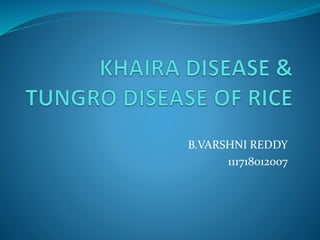
KHAIRA DISEASE AND TUNGRO DISEASE OF RICE
- 2. DISEASE NAME:- Khaira disease of rice. Causal agent:- • This disease occurs due to zinc deficiency. • It is a non-parasitic and non-infectious disease.
- 3. SYMPTOMS Dusky brown spots on upper leaves of stunted plants. Uneven plant growth. Increase spikelet sterility in rice. Chlorotic midribs particularly near the leaf base of younger leaves. Leaf blade size is reduced.
- 6. MANAGEMENT Grow zinc efficient varieties (oryza nivara,oryza rufipogon). Use fertilizers that generate acidity(example:-replace some urea with ammonium sulphate). Apply organic manure before seeding in nursery or transplant of rice in main fields. Monitor irrigation water quality. Broadcast znso4 in nursery seedbed 5days before pulling out of seedlings.
- 7. Dip seedlings or presoak seeds in a 2-4% ZnO suspension. Znso4 25-30kg/ha as soil application at the time of puddling. Mix 5kg znso4+2.5kg slaked lime+1000 liters water and sprayed it on 10-20days after sowing in nursery.
- 8. RICE TUNGRO DISEASE It is caused by the combinaion of two viruses,which are transmitted by leafhoppers.it cause leaf discolouration,reduce tiller number. 1.Tungro bacilliform virus. 2.Tungro spherical virus. Tungro infects cutivated rice,some wild rice relatves and other grassy weeds found in rice fields.
- 9. SYMPTOMS Yellowing or orange-yellow discolouration is noticeable in tungro infected plants. Yellowing starts from the tip of the leaf and may extend to lower parts of the leaf blade. Stunted growth,delay flowering, which may delay maturity. Most panicles sterile or partially filled grains.
- 10. Yellowing and orange yelow discolouration of leaves. Stunted with reduced tillering.
- 11. PATHOGEN Two morphologically unrelated viruses present in phloem cells. Rice tungro bacilliform virus (RTBV) bacilliform capsid, circular ds DNA genome and Rice tungro spherical virus (RTSV) isometric capsid ss RNA genome
- 12. PATHOGEN CHARACTERS RTBV-dsDNA Bacilliform virus,which cause mild stunting and yellowing of leaves. RTSV-ssRNA virus,which causes only very mild stunting,without leaf symptoms.
- 13. Disease Cycle Transmission mainly by the leaf hopper vector Nephotettix virescens Males, females and nymphs of the insect can transmit the disease. Both the particles are transmitted semi-persistently, in the vector the particles are noncirculative and nonpropagative. Plants infected with RTSV alone may be symptomless or exhibit only mild stunting.
- 14. RTBV enhances the symptoms caused by RTSV. RTSV can be acquired from the infected plant independently of RTBV, but acquisition of RTBV is dependent on RTSV which acts as a helper virus. The viruses thrive in rice and several weed hosts which serve as source of inoculum for the next. Ratoon from infected rice stubble serve as reservoirs of the virus. Disease incidence depends on rice cultivars, time of planting, time of infection and presence of vectors and favorable weather condition.
- 15. Management Field sanitation, removal of weed hosts of the virus and vectors. Grow disease tolerant cultivars like Pankhari203, BM66, BM68, Latisail, Ambemohar102, Kamod253, IR50 and Co45. Control the vectors in the nursery by application of Carbofuran 170 g/cent 10 days after sowing to control hoppers.
- 16. Spray Phosphomidan 500 ml or Monocrotophos 1lit/ha (2 ml/litre) or Neem oil 3% or NSKE 5% to control the vector in the main field 15 and 30 days after transplanting. Set up light traps to monitor the vector population.
- 17. THANK YOU
